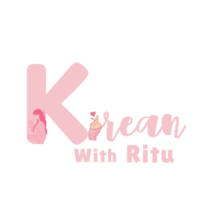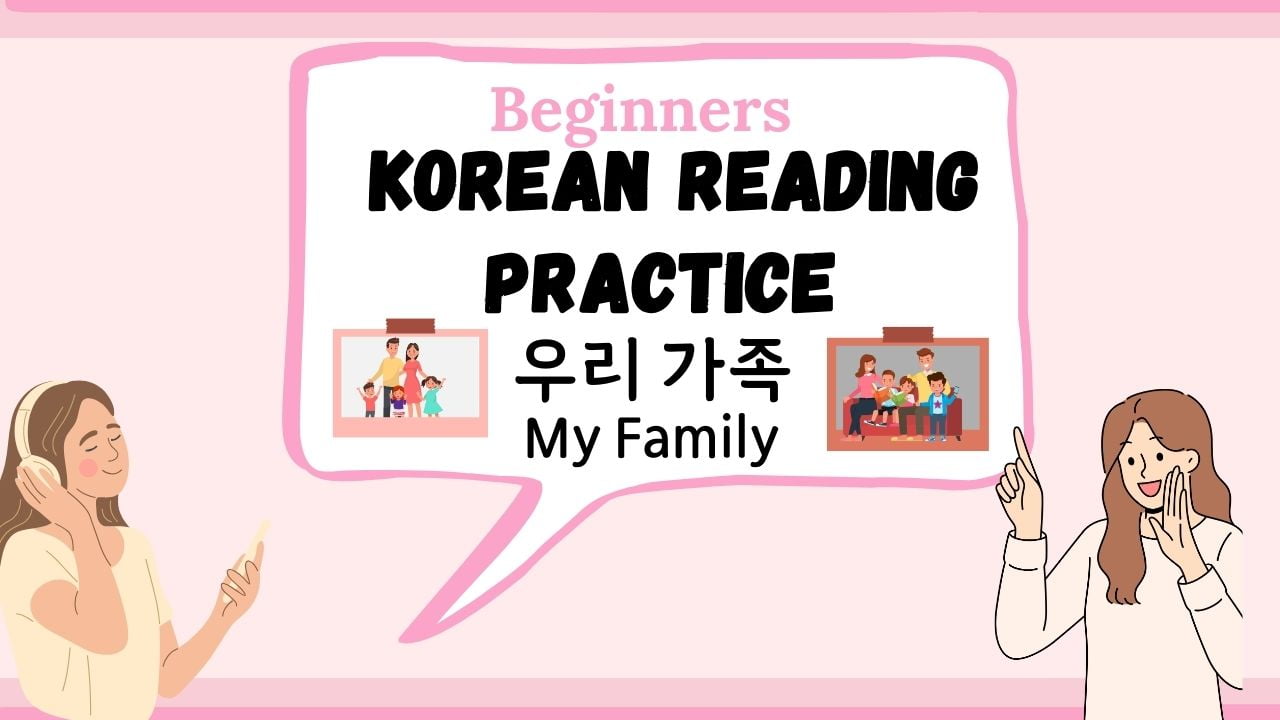Hi guys, today we will do an easy Korean reading practice session for beginners with a short passage on My Family.
Table of Contents
Korean Reading Practice: My Family
우리 가족
There will be two passages following similar script in this lesson. Since males and females use different addressing words for their brothers and sisters, we’ll have two characters [ Im Sol and Seojae ] of opposite sexes introducing their family. So through this lesson, you’ll be able to easily understand those differences. Let’s start with our female character Im Sol who will be introducing her family first.
임솔 씨의 가족: Im Sol’s Family
Formal Speech
안녕하세요? 저는 임솔입니다.
우리 가족는 모두 다섯 명입니다.
저는 아버지와 어머니, 오빠가 하나,여동생이 한 명이 있습니다.
아버지는 의사입니다.
어머니는 수학 선생님입니다.
오빠는 회사원입니다.
여동생은 고등학생입니다.
여동생하고 저는 쇼핑을 좋아합니다.
그래서 주말에 백화점에 쇼핑하러 함께 갑니다.
저는 대학생입니다.
저는 공무원이 되고 싶어서 지금은 열심히 공부합니다.
Informal Polite Speech
안녕하세요? 저는 임솔이에요.
우리 가족는 모두 다섯 명이에요.
저는 아버지와 어머니, 오빠가 하나,여동생이 한 명이 있어요.
아버지는 의사예요.
어머니는 수학 선생님이에요.
오빠는 회사원이에요.
여동생은 고등학생이에요.
여동생하고 저는 쇼핑을 좋아해요.
그래서 주말에 백화점에 쇼핑하러 같이 가요.
저는 대학생이에요.
저는 공무원이 되고 싶어서 지금은 열심히 공부해요.
Translation (Click to unfold)
Hello. I’m Im Sol.
My Family has a total of 5 members.
I have a father and a mother, one elder brother, and one younger sister.
My father is a doctor.
My mother is a mathematics teacher.
My elder brother is an office-worker.
My younger sister is a high school student.
My sister and I both like shopping.
So we go to department store to do shopping together on the weekends.
I’m an University student.
I want to become a civil servant so I’m studying hard right now.
Now let’s move on to our male character, Seonjae’s family introduction.
선재 씨의 가족: Seonjae’s Family
Formal Speech
안녕하세요? 저는 선입니다.
우리 가족는 모두 다섯 명입니다.
저는 아버지와 어머니, 형이 하나, 누나가 한 명이 있습니다.
아버지는 사업가입니다.
어머니는 소설 작가입니다.
형은 축구 선수입니다.
누나는 승무원입니다.
형하고 저는 테니스를 좋아합니다.
그래서 주말에 태니시를 함께 칩니다.
저는 대학생입니다.
저는 가수가 되고 싶어서 지금은 노래 연습을 열심히 합니다.
Informal Polite Speech
안녕하세요? 저는 선재예요.
우리 가족는 모두 다섯 명이에요.
저는 아버지와 어머니, 형이 하나, 누나가 한 명이 있어요.
아버지는 사업가예요.
어머니는 소설 작가예요.
누나는 승무원이에요.
형은 운동 선수예요.
형하고 저는 테니스를 좋아해요.
그래서 주말에 태니시를 같이 쳐요.
저는 대학생이에요.
저는 가수가 되고 싶어서 지금은 노래 연습을 열심히 해요.
Translation (Click to unfold)
Hello. I’m Seonjae.
My Family has a total of 5 members.
I have a father, mother, one elder brother, and one elder sister.
My father is a businessman.
My mother is a novelist.
My elder sister works as an air-hostess.
My elder brother is a Football player.
My brother and I both like tennis.
So we play tennis together every weekend.
I’m a University student.
I want to become a singer so I practice singing hard right now.
Now let’s move on to our male character, Seonjae’s family introduction.
Vocabulary
| Word | Meaning |
|---|---|
| 안녕하세요? | Hello |
| 저 | I, me |
| 가족 | Family |
| 모두 | All |
| 다섯 | Five |
| 명 | Person |
| 아버지 | Father |
| 어머니 | Mother |
| 오빠 | Elder brother (Female use it to address elder brother) |
| 여동생 | Younger sister (Both male and female can use it to address younger sister) |
| 누나 | Elder sister (Male use it to address elder sister) |
형 | Elder brother (Male use it to address elder brother) |
| 하나 | One |
| 의사 | Doctor |
| 수학 | Mathematics |
| 선생님 | Teacher |
| 회사원 | Office worker |
| 고등학생 | High school student |
| 쇼핑 | Shopping |
| 좋아하다 | To like |
| 주말 | Weekend |
| 백화점 | Department store |
| 쇼핑하다 | To do shopping |
| 함께/같이 | Together, along with |
| 대학생 | University student |
| 공무원 | Civil servant |
| 되다 | To become |
| 공부하다 | To study |
| 열심히 | Hard, diligently |
| 사업가 | Businessman |
| 소설 작가 | Novelist |
| 승무원 | Air-hostess |
| 축구 선수 | Football player |
| 테니스 | Tennis |
| 주말 | Weekend |
| 치다 | To hit, strike |
| 태니시를 치다 | To play tennis |
| 가수 | Singer |
| 지금 | Right now |
| 노래 | Song |
| 열심히 | Hard, diligently |
| 연습 | Practice |
| 하다 | To do |
Grammar Points:
Noun+이다
이다 is the root form of 입니다 and 이에요/예요 grammar ending.
이다 means “to be” and it is always attached to a noun.
When you want to make a sentence that goes like:
Subject is/am/are noun.
My name am Ritu.
제 이름은 리뚜이다.
Here, is/am/are is expressed through 이다.
Let’s take the Subject as A and Noun as B.
Sentence structure: A+은/는 B+이다.
This expresses A is B or A equals B.
Formal Grammar Ending of N+이다
Now after getting the basics right, let’s learn the Formal grammar ending of N+이다.
Noun+입니다:
입니다 is used as predicative and interrogative ending and is attached to a noun.
Sentence structure: A+은/는 B+입니다.
Here, the subject of the sentence is A and Noun is B.
Example: 아버지는 의사입니다.
My father is a doctor.
Informal Polite Grammar Ending of N+이다
Let’s learn the Informal Polite Grammar ending of N+이다~
Noun+이에요/예요:
이에요/예요 is used as predicative and interrogative ending and is attached to a noun.
Sentence structure: A+은/는 B+이에요/예요.
Example: 어머니는 선생님이에요.
My mother is a teacher.
When the noun has a final consonant [받침], 이에요 is attached to the noun.
선생님 -> 선생님이에요
When the noun has no final consonant [받침] , 예요 is attached to the noun.
의사 -> 의사예요
Present Tense Grammar Ending
Now we’ll learn the most basic and most useful grammar ending.
Formal Present Tense Grammar Ending
Verb/ Adjective+ㅂ니다/습니다
The present tense in Korean is used to describe actions occurring now i.e. “I eat” and “I go”. As you already know the verbs and adjectives are present in their root form [먹다] in Korean and you have to conjugate them in order to change it to present tense.
First step is to remove the -다 from the root form.
Here are three ways to form the present tense:
습니다 Conjugation:
When the stem ends in a consonant, add -습니다 to the stem.
Examples:
- 먹다 – to eat
- 먹 + 습니다 => 먹습니다 /I eat/
- 읽다 – to close
- 읽 + 는다 => 읽습니다 /I read/
Example Sentences:
- 라면을 먹습니다. /I eat ramen./
- 책을 읽습니다. /I read a book./
ㅂ니다 Conjugation:
When the stem ends in a vowel, add -ㅂ니다 to the stem.
Examples:
- 가다- to go
- 가 + ㅂ니다 => 갑니다 /I go./
- 치다- to hit
- 치 + ㅂ니다 => 칩니다 /I hit./
Example Sentences:
- 집에 갑니다. /I go home./
- 테니스를 칩니다. /I play tennis./
Informal Polite Present Tense Grammar Ending
Verb/Adjective +아서/어서/여서
This speech is most used in daily life. Let’s take a look at how to use it.
아서 Conjugation:
When word stem ends with vowels ㅏand ㅗ, 아요 is added.
Examples:
- 가다– to go
- 가 + +아요 = 가요 /I go./
- 보다– to see
- 보+아요 = 봐요 /I see./
Example Sentences:
- 집에 가요. I go home.
- 영화를 봐요. I watch movies.
어서 Conjugation:
When word stem ends with vowels other thanㅏand ㅗ, 어요 is added.
Examples:
- 쓰다– to write
- 쓰+ 어요 => 써요 /I write./
- 마시다– to drink
- 마시+ 어요=> 마셔요 /I drink./
Example Sentences:
- 글을 써요. /I write a script./
- 물을 마셔요. /I drink water./
여서 Conjugation:
When the word has 하다, it is changed 해요
Examples:
- 좋아하다– to like
- 좋아하+ 여요 => 좋아하다 / I like./
Example Sentences:
- 쇼핑을 좋아해요. /I like shopping./
N+이/가 있다- “To have” Grammar Form
Noun+ 이/가 있다
The verb 있다 indicates the existence of something (to have) and the verb 없다 indicates the absence (to not have).
The subject particles -이/가 is attached to the noun which is the subject of the sentence.
Sentence structure: N1은/는 N이/가 있다
This expresses “N1 has N2”.
Examples:
저는 여동생이 있어요.
I have a younger sister.
저는 누나가 있어요.
I have an elder sister.
N+ 이/가 되다- “To become” Grammar Form
Noun+ 이/가 되다
되다 means “to become,” as in “something/someone will become a certain thing/person in the future.”
Take a noun (what the person, or thing, is going to become), and attach the Subject Marker (이/가). Then conjugate the verb 되다.
Example:
저는 의사가 되고 싶어요.
I want to become a doctor.
그래서- “Because” Conjugation
The conjunction 그래서 indicates the cause-and-effect relation between two sentences. Simply put, 그래서 is like saying “so” or “therefore.”
Example:
배고파요. 그래서 밥을 먹고 싶어요.
I’m hungry. Therefore, I want to eat food.
V/adj +아서/어서/여서- “Reason” Grammar Form
Verb/Adjective + 아서/어서/여서
It is used to denote that former clause is the reason for the latter clause.
The conjugation rules are similar to Present tense grammar ending.
Example:
배고파서 밥을 먹고 싶어요.
I’m hungry so I want to eat food.
V+ 고 싶다- “Want to” Grammar Ending
Verb+ 고 싶다
This Korean grammar ending is used to express one’s wishes or desires.
Example:
저는 가수가 되고 싶어요.
I want to become a singer.
V-(으)러 가다/오다- “Intention” Grammar Ending
Verb-(으)러 가다/오다
V+(으)러 가다/ 오다 Korean grammar pattern is used to express the intention or purpose of going and coming somewhere.
Example:
백화점에 쇼핑하러 가요.
I go to the department store to do shopping.
N+ 하고- “And” Grammar Form
Noun+ 하고
하고 carries the meaning of “and,” You just have to attach it to a noun without a gap.
Example:
My younger sister and I like tennis.
여동생하고 저는 테니스를 좋아해요.
N+ 하고- “And” Grammar Form
N+ 와/과- “With” Grammar Form
Noun+ 와/과
For formal use of ‘with/with together’ in Korean, article 와/과 can be used.
와 is used when the subject noun ends with a vowel, and 과 is used when the subject noun ends with a consonant.
Examples:
- 어머니와 아버지가 저녁을 만들고 있어요. /Mother is cooking food with father./
- 임솔과 선재는 여행을 가요. /Im Sol goes on a vaction with Seonjae./
Practice Quiz
Q1 “어머니와 아버지.” What does 와 means?
- father
- with
- too
- mother
Q2 Fill in the blanks. “저는 선생님 _______.” /I want to become a teacher./
- 가 아닙니다
- 예요
- 되고 싶어요
- 있습니다
Q3 Fill in the blanks. “잠 잘 못 잤어요. _________ 자고 싶어요.”
- 그래서
- 그리고
- 그럼
- 하지만
Q4 Fill in the blanks. “아버지는 의사 _______.”
- 이에요
- 예요
- 고 싶어요
- 돼요
Q5 Fill in the blanks. “저는 여동생이 한 명이 __________.”
- 이에요
- 예요
- 되고 싶어요
- 있습니다
Q6 “제 누나는 춤을 잘 춰요.” “누나” is used as?
- male use it to address elder brother
- female use it to address elder sister
- male use it to address elder sister
- female use it to address elder brother
Q7 Fill in the blanks. “시장에 쇼핑하___________.”
- 예요
- 이에요
- 고 싶어요
- 러 가요
Answers (Click to unfold)
Q1 2
Q2 3
Q3 1
Q4 2
Q5 4
Q6 3
Q7 4



